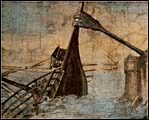
| Back to . . . | This section . . . |
Other machines invented by Archimedes were directed against the assault parties as they advanced under the shelter of screens which protected them against the missiles shot through the walls. Against these attackers the machines could discharge stones heavy enough to drive back the marines from the bows of the ships; at the same time a grappling-iron attached to a chain would be let down, and with this the man controlling the beam would clutch at the ship. As soon as the prow was securely gripped, the lever of the machine inside the wall would be pressed down. When the operator had lifted up the ship's prow in this way and made her stand on her stern, he made fast the lower parts of the machine, so that they would not move, and finally by means of a rope and pulley suddenly slackened the grappling-iron and the chain. The result was that some of the vessels heeled over and fell on the sides, and others capsized, while the majority when their bows were let fall from a height plunged under water and filled, and thus threw all into confusion.(Translation by Ian Scott-Kilvert in The Rise of the Roman Empire, Penguin Classics, New York, 1980, Page 367.)
Some of the enemy ships came close in-shore, too close for the artillery to touch them; and these he dealt with by using a swing-beam and grapnel. The method was this: the swing-beam projected over the wall and an iron grapnel was attached to it on a heavy chain; the grapnel was lowered on to a vessel's bows, and the beam was then swung up, the other arm being brought to the ground by the shifting of a leaden weight; the result was to stand the ship, so to speak, on her tail, bows in air. Then the whole contraption was suddenly let go, and the ship, falling smash as it were from the wall into the water (to the great alarm of the crew), was more or less swamped even if it happened to come down on an even keel.(Translation by Aubrey de Selincourt in The War with Hannibal, Penguin Classics, New York, 1965, Page 273.)
At the same time huge beams were run out from the walls so as to project over the Roman ships: some of them were then sunk by great weights dropped from above, while others were seized at the bows by iron claws or by beaks like those of cranes, hauled into the air by means of counterweights until they stood upright upon their sterns, and then allowed to plunge to the bottom, or else they were spun round by means of windlasses situated inside the city and dashed against the steep cliffs and rocks which jutted out under the walls, with great loss of life to the crews. Often there would be seen the terrifying spectacle of a ship being lifted clean out of the water into the air and whirled about as it hung there, until every man had been shaken out of the hull and thrown in different direction, after which it would be dashed down empty upon the walls.(Translation by Ian Scott-Kilvert in Makers of Rome: Nine Lives, Penguin Classics, New York, 1965, Page 100.)
And when once Marcellus, the Roman general, was assaulting Syracuse by land and sea, this man first by his engines drew up some merchantmen [ships], and lifting them up against the wall of Syracuse dropped them again and sent them every one to the bottom, crews and all.(Translation by Ivor Thomas in Greek Mathematical Works, Loeb Classical Library, Harvard University Press, Cambridge, 1941.)
And he would lift up ships, even those equipped with towers, by means of other appliances which he dropped upon them; and raising them aloft, would let them drop suddenly, so that when they fell into the water they were sunk by the impact.(Translation by Earnest Cary in Dio's Roman History, Volume II: Fragments of Books XII-XXV, Loeb Classical Library, Harvard University Press, Cambridge, 1914.)